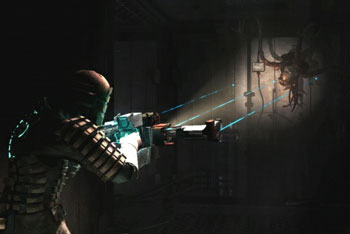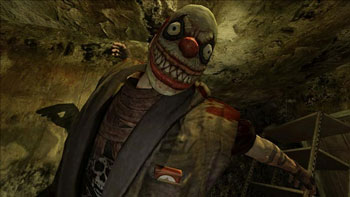Stay Up To Date With Us!
We will never spam you or share your email address.
Game Sound Design Strategies
GSD StrategiesCheck out the gamesounddesign.com strategies when you are feeling creatively uninspired. Each random strategy will present you with a new avenue to pursue. Give them a try!
Game Sound Design Glossary
GSD GlossaryOur game audio glossary has all the sound terms you have been wondering about. Game audio can be confusing enough without having to deal with a new technical language. We are constantly updating the database with new terms that relate to not only game audio but game developer terms as well.
Silence In Sound Design
Article by George Spanos
Silence is a very powerful sound.
Sound? Silence is not a sound... right?
Well I think that silence should be considered a "sound", a "sound effect", and "music". But that's crazy isn't it... how can the lack of sound be considered the same as the presence of sound? After all, sound is created by sending electrical energy to an amplifier which is then sent to a transducer that converts the electrical signals into sound waves that we hear. But the lack of sound in a game can often have a profound impact to the gaming audience.
The Loud Factor
One of the most fundamental aspects to clever sound design is the ability to use silence, or near-silence as you would any other sound. The problem is that silence is not a sound so we don't commonly think of using it in general applications. People who are unfamiliar with the art of sound design do not really understand the creative use of silence in video games. They have a hard time understanding its creative use in linear formats too, like film and television programs. But put into a broader context it will make sense to the uninitiated. It just has to be used as a device that helps to amplify emotion. And emotion is a big part of why gamers play games.
The trend these days is to have the loudest gunshots, explosions, music, and to generally over compress assets in a game. After all, Hollywood does it and most popular music does it so why shouldn't games? The problem is that we as game designers are creating worlds where the player becomes immune to the unexpected and ironically, loud isn't loud anymore. When all sounds are limited and normalized then you simply have an overall loud gaming experience. You lose dynamics, and dynamics are what makes a sound, or group of sounds interesting. This is fundamental.
There is definitely a time and a place for the loud factor. The problem is that repetition is desensitizing. The need to punctuate certain in-game events with bombast provides diminishing returns when used constantly.

Using silence or near-silence can often elicit a more emotional response from the player. Because we are constantly bombarded with sensory information in the average first or third person shooter, silence can result in an incredibly powerful moment of clarity for the player. There is no music or other extraneous noise to tell the player how to feel about the given situation. This will enable a deeper attachment with the character that the player is trying to embody. The player's attention will focus in on what is happening on screen and will be forced to feel genuine emotion... because the player isn't being told what to feel by over the top music and sound effects.
There are plenty of examples where silence is golden. One very common application is in war type shooters. Flashbangs generally temporarily blind and deafen the player and the use of this technique can be very successful. The main reason being is that by removing any sensory input from the gameplay, the player is forced to suddenly think in many different strategies. Should he run? Should he blind-fire? Should he try to take cover? Removing sound and sight in this way can really add another huge dimension to gameplay.
Another great example is in the movie Saving Private Ryan when the troops first make it off the boat and are in the water in the Omaha Beach scene. The camera is giving the viewer an underwater point of view of bullets that are piercing the surface and killing soldiers but the sound is very muted and only the most important sounds are able to peek through, such as the muffled screams. There is another scene near the end of the film where Captain John H. Miller is observing his troops being shot at by the Germans. This scene is especially poignant and the minimalist sound design helps to underscore the Captain's thought process during the attack which enables the viewer to really get inside Captain Miller's headspace with only the most necessary sounds. It is also very interesting to note that there is a lack of music in these two scenes, further punctuating the visceral nature of the moments that the director is trying to capture.
Of course the above examples feature specific moments and scenes designed for the very purpose to allow the lack of sound to work. The design and story are both significant contributing factors in the success of both of the above examples.
What Makes Silence Work?
The best case scenario is to design the gameplay or cinematics with audio in mind. Very few games are actually scripted out in this manner due to the fact that it is not always easy to predict what the player will do next. Cinematics within the game can lend themselves to the use of silence as they are predictable and are very linear.
Silence does not have to mean that absolutely all the sound from the scene is removed. In the case of the flashbang example, quite often a high pitched tone will be heard as if to simulate the temporary loss of hearing and general disorientation of the player. Other times the sound may be "muffled" or "muted" by the use of equalization and volume control. Another technique is to remove all but the most necessary sounds to communicate the scene. This can be particularly effective when trying to get the player to focus his attention on specific events. The sound acts as a "pointer" to focus attention.

It is important to remember that silence or near-silence can act as a far greater emotive tool when it is either preceeded or succeeded by loudness. The impact of the silence will provide more value for the money if it stands in stark contrast to the events that surround it. Imagine watching a black and white television and then suddenly turning on the color. The contrast is obvious.
If the sound designer were to design ambiences in a horror genre game that lend themselves to let the scary moments speak, then the overall drama of the quiet moments will be punctuated. As the player walks down dark, deserted hallways searching for the unknown, only to hear faint noises in the distance with subtle ambience that surrounds his every move, then the payoff will be greatly heightened. The scariest part of a horror movie or video game is often the tense moments leading up to the "surprise".
Dead Space is an excellent example of this technique. As you navigate dark corridors on the abandoned ship the player is just waiting for that next moment to pop out at him. The reason holding back on extraneous sound in this type of situation works is because you then have somewhere to go with the sound design. As mentioned earlier, by taking away or severely impeding the player's auditory sense you will actually make him focus more on the gameplay leading up to the moment of shock when he is ambushed by the alien creatures.

Another great example of this is in the game Condemned. The gameplay really lets the sound speak as the player wanders around deserted buildings and empty streets looking for killers. In fact, there are key moments in the game that rely heavily on the silence that preceed them, not to mention that breaks of silence are often impacted with times of heavy attack. Again, this forces the player to really focus in on the lack of obvious sound so that he may try to anticipate what is coming next.
The Opposite Factor
Humans are conditioned to react to sound. When we cross the street we are very aware of the danger that we are about to step into. Even though hearing is not necessarily a conscious process, it is important to pay attention to what your ears are telling you. Because gamers are expecting to hear that loud gunshot or mortar going off it will often feel very surreal to downplay those types of events, especially at key moments of gameplay. By not playing the sound as loud as possible and moving in the opposite direction by either creating absence of sound or deftly lowering the volume one can actually draw more attention to what is happening on screen. People hear without thinking about it, just as our hearts beat without us consciously being aware. But once the sound designer takes away this fundamental perception, it focuses the gamer's attention to what is happening on the screen. All of a sudden the player must really focus on the moment rather than letting his sense of hearing do the talking.
This is perhaps the single most fundamental aspect of silence as the ultimate conveyance tool. Because of the lack of auditory information, the other senses - touch and sight - will be relied more heavily upon by the brain. As soon as the sound designer deprives the player of sound subconsciously the player's attention will become more sharp and focused to the events on screen. When not over used, silence can have a very visceral impact on the gameplay because it is not something that the player is expecting. The important thing to remember is to not over use the technique but rely on it to add that extra dimension of focus for those moments when clarity and attention need to be conveyed.
Obviously, it is important to not over use the technique of silence or it too, will lose it's impact. There will be moments in the gameplay where using silence will be the most beneficial and it is the sound designer's job to identify those instances. Cinematics can provide a great setup for these moments especially when it is important to convey the inner thoughts of the character the gamer is trying to become. It is important to analyze the given situation and ask yourself if using silence can speak louder than volume.

